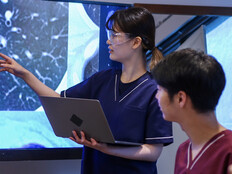The Differences Between Screen Casting vs Screen Mirroring vs Screen Sharing in Higher Education
Active learning, collaboration, personalization, flexibility and two-way communication are the main factors driving today’s modern classroom design.
Among the technologies being brought to bear in academic settings are those that enable screen mirroring, screencasting and screen sharing, often collectively referred to as wireless presentation solutions.
These technologies are often supported by a device and app that allow users, both students and professors, to easily share content on a larger screen in a classroom.
“The next best thing to a one-to-one conversation is to be able to share what the students create, as part of the homework or class activity, or communicate using media to provide video evidence of class activities and enhance and build out reading, writing, speaking, listening, language and other skills,” says Michael Volpe, marketing manager for IOGEAR.
MORE FROM EDTECH: Check out how universities are improving online education.
Comparing Wireless Presentation Solutions
While some may use the terms casting, mirroring and sharing interchangeably, there are actually key differences among them, which come into play when choosing the right solution for a particular institution.
Screen mirroring allows you to project your mobile device or laptop onto a TV screen, projector or other type of monitor. This allows you to share everything you do on your device, such as switching between documents or playing video.
Screencasting is similar to mirroring but is used to share online content, such as movies, video clips and music, from a phone, tablet or computer on a TV or other screen. The difference is that only the media is streamed, allowing you to continue to use your device without interrupting the stream.
Then there’s screen sharing, also known as desktop sharing, which usually involves providing another user with access to your screen on their screen. This enables individuals in different locations to collaborate on projects. Generally speaking, screen sharing isn’t used very much in educational settings.
Benefits of Screensharing, Screencasting and Screen Mirroring
Increased ease of use and lower costs are among the reasons these solutions have seen more widespread adoption in recent years, hitting a significant sales figure in 2018.
“The market for commercial-grade wireless presentation solutions passed a major milestone in 2018, with shipments of wireless presentation solutions — whether hardware-based, room hubs, collaboration displays or software — reaching 1 million units globally,” says Ben Davis, senior analyst for education content and platforms for Futuresource Consulting. “The education vertical has been a strong adopter of these technologies in North America, where 33 percent of product shipments during 2018 serviced the education market.”
This growth has been seen in both K–12 and higher education markets, where one-to-one computing models have created a surge in demand for products that can support sharing from multiple devices and various operating systems.
“In the higher education space, educators are taking advantage of mature BYOD environments to enable collaboration while also being capable of scaling across campuses to service rising demand for these solutions,” Davis says. “Here, more advanced wireless presentation solutions are demanded, often including advanced feature sets such as whiteboarding, usage analytics and multiroom functionality, to share content over a network.”
The ability to quickly engage in interactive conversation with multiple participants is perhaps the biggest benefit of both screen mirroring and screencasting technologies.
“You can have a conversation with students pulling things up on their computers or their tablets to share on the big screen to emphasize their point, utilizing technology to strengthen their arguments to have a more dynamic classroom setting. For example, if one student mentioned something, another could pull it up on their device and share it to the big screen so the conversation can continue and everyone is on the same page,” Volpe says.
MORE FROM EDTECH: Here are a few ways institutions can create their own active-learning classroom.
Keys to Deploying Solutions
When deploying a screen mirroring or screencasting solution, the most important factor is reliability, which often goes hand in hand with ease of use. After all, if a solution doesn’t work regularly or is difficult to figure out, an instructor is not going to use it. And while consumer solutions are often very intuitive, they are not well suited to academic environments.
“Reliability has to be No. 1. We can’t use consumer-grade technology because it has to work with our enterprise authentication system. It just has to work every time. Integration teams don’t want to get a phone call and have to send someone out to the classroom because an instructor has 200 people staring at them because the screencasting system isn’t working,” says Jake Kulstad, assistant director for learning technologies at the University of Washington.
Another important criterion for selecting and deploying a solution for higher education is its ability to work with a variety of operating systems and devices, which Kulstad says can be tricky.
“If you buy into an iOS ecosystem, which a lot of people haven’t, the instructor can pull out an iPad and with a little skill, they can have a pretty solid experience. In fact, you can look like a rock star with an iPad. But from an enterprise perspective, cross-compatibility is extremely important,” Kulstad says.
As universities continue to push for collaborative, active-learning spaces and video-driven content, the presence of wireless presentation solutions is expected to grow in higher education. This means IT leaders would do well to begin planning now, so they don’t fall behind.










